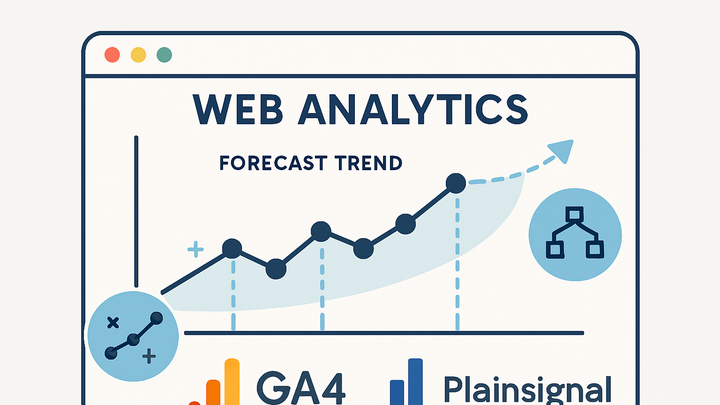Published on 2025-06-26T04:57:18Z
What is Predictive Modeling? Examples for Analytics
Predictive modeling in analytics refers to the application of statistical algorithms and machine learning techniques to historical data in order to forecast future outcomes. By identifying patterns in past user behavior, predictive models provide insights that guide business decisions—from estimating customer churn to projecting sales performance. This process involves selecting relevant features, training algorithms, and validating model accuracy to ensure reliable predictions. In modern web analytics, tools like Google Analytics 4 (GA4) offer out-of-the-box predictive metrics such as purchase probability and churn probability, while privacy-forward platforms like PlainSignal deliver event-level data without cookies to fuel custom predictive pipelines. When implemented effectively, predictive modeling empowers teams to optimize marketing spend, personalize user experiences, and proactively address emerging trends. However, success depends on high-quality data, ongoing validation, and mindful consideration of privacy and ethical concerns.
Predictive modeling
Apply machine learning on analytics data to forecast future outcomes like churn or sales, informing decisions and personalizing user experiences.
What is Predictive Modeling?
Predictive modeling uses historical analytics data and algorithms to predict future outcomes. It transforms raw event logs into actionable forecasts that inform strategy.
-
Definition
Predictive modeling is the process of using statistical algorithms and machine learning techniques to analyze historical data and predict future events or behaviors.
-
Common use cases
Businesses leverage predictive models to anticipate customer behavior and optimize operations:
-
Churn prediction
Identify customers likely to cancel subscriptions or stop engagement.
-
Sales forecasting
Estimate future revenue based on past sales trends.
-
Personalization
Serve content or offers tailored to predicted user preferences.
-
Why Predictive Modeling Matters
Predictive modeling elevates analytics from descriptive hindsight to forward-looking insight, enabling proactive decision-making.
-
Improve decision-making
Provides data-driven forecasts that guide marketing, product, and operational strategies.
-
Increase roi
Helps allocate budgets more effectively by focusing on high-value opportunities.
-
Enhance user experience
Enables personalized journeys by predicting individual user needs and preferences.
Key Techniques in Predictive Modeling
A variety of algorithms power predictive models; choosing the right technique depends on your data and objectives.
-
Regression analysis
Quantifies relationships between independent variables and a continuous target outcome.
-
Linear regression
Models linear relationships by fitting a straight line to data.
-
Logistic regression
Predicts the probability of a binary outcome using a logistic function.
-
-
Classification
Assigns categorical labels to observations based on predictor variables.
-
Decision trees
Splits data into branches to predict class labels.
-
Random forests
Ensembles multiple decision trees to improve accuracy.
-
-
Time series forecasting
Analyzes sequential data points to predict future values over time.
-
Arima models
Uses autoregression, differencing, and moving averages to capture patterns.
-
Exponential smoothing
Weights recent observations more heavily for short-term forecasting.
-
-
Clustering
Groups similar data points without predefined labels to discover patterns.
-
K-means
Partitions data into K clusters based on distance metrics.
-
Implementing Predictive Modeling with PlainSignal and GA4
Combine privacy-first data collection from PlainSignal with GA4’s built-in predictive metrics or export data to custom ML pipelines.
-
Using PlainSignal for data collection
PlainSignal offers cookie-free event tracking that can feed predictive models with rich user-level data.
-
Installation
Add the following snippet to your HTML:
<link rel="preconnect" href="//eu.plainsignal.com/" crossorigin /> <script defer data-do="yourwebsitedomain.com" data-id="0GQV1xmtzQQ" data-api="//eu.plainsignal.com" src="//cdn.plainsignal.com/plainsignal-min.js"></script> -
Data export
Use PlainSignal’s API to export event data into your predictive modeling pipeline or data warehouse.
-
-
Leveraging GA4 predictive metrics
GA4 includes built-in predictions you can segment and report on without custom coding.
-
Purchase probability
Estimates the likelihood a user will complete a purchase within the next 7 days.
-
Churn probability
Predicts the chance a user will become inactive in the next 28 days.
-
Revenue prediction
Forecasts potential revenue from active user segments over a defined period.
-
Best Practices and Considerations
Effective predictive modeling balances technical rigor with ethical and privacy safeguards.
-
Ensure data quality
Verify accuracy, completeness, and consistency of historical data before modeling.
-
Validate models regularly
Use cross-validation and holdout sets to assess performance and avoid overfitting.
-
Monitor for bias and privacy
Check models for unfair biases and ensure compliance with GDPR, CCPA, and other regulations.
-
Iterate and update models
Retrain models with fresh data to maintain accuracy as user behaviors and market conditions change.
